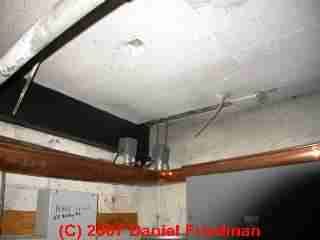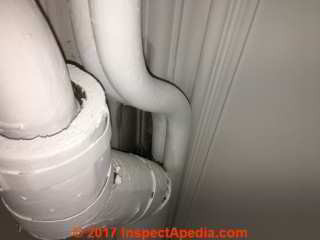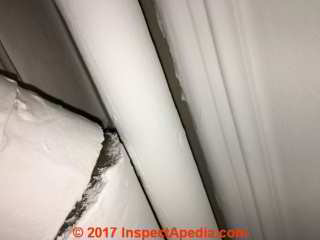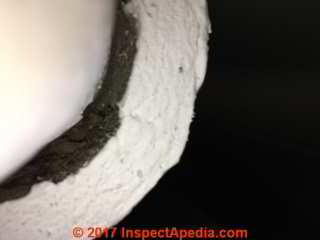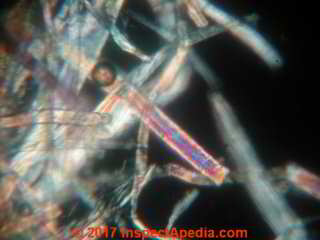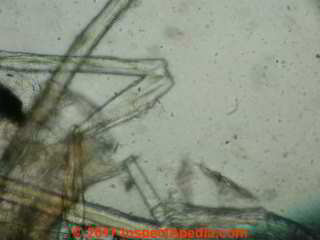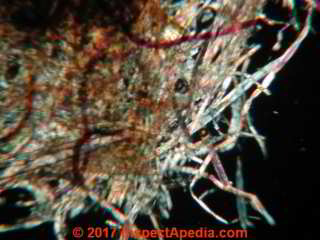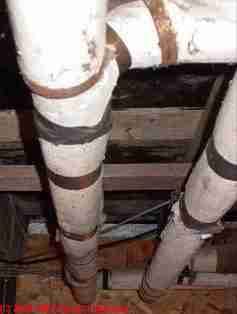 Photographs of Asbestos in Good Condition
Photographs of Asbestos in Good Condition
- POST a QUESTION or COMMENT about when asbestos materials can or should be left alone & how to recognize asbestos materials that are undamaged and in good condition
Asbestos that can often be safely left in place:
This article illustrates asbestos insulating and other products which are in good condition and discusses what to do about the asbestos material in that case.
This document assists building buyers, owners or inspectors who need to identify asbestos materials (or probable-asbestos) in buildings by simple visual inspection. We provide photographs and descriptive text of asbestos insulation and other asbestos-containing products to permit identification of definite, probable, or possible asbestos materials in buildings.
InspectAPedia tolerates no conflicts of interest. We have no relationship with advertisers, products, or services discussed at this website.
- Daniel Friedman, Publisher/Editor/Author - See WHO ARE WE?
Examples of Visually-recognizable Asbestos Materials in Buildings that are in Good Condition and may be able to remain in place
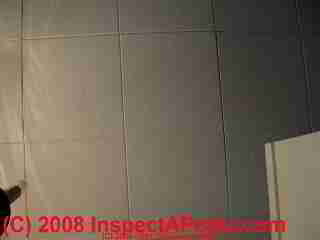
While an expert lab test using polarized light microscopy may be needed to identify the specific type of asbestos fiber, or to identify the presence of asbestos in air or dust samples, many asbestos-containing building products not only are obvious and easy to recognize, but since there were not other look-alike products that were not asbestos, a visual identification of this material can be virtually a certainty in many cases.
The ceiling tiles at left may contain asbestos. They are in good condition and are not subject to mechanical damage by the occupants of the building.
If these ceiling tiles are to be removed, the demolition could release high levels of asbestos fibers - appropriate asbestos removal procedures would be wise.
Also see ASBESTOS DUCTS, HVAC a field identification guide to visual detection of asbestos in and on heating and cooling system ducts and flue vents.
Also see Micro-Photographs of Dust from the World Trade Center collapse following the 9/11/01 attack
. Links to U.S. government and other authoritative research and advice are included.
Asbestos Insulation in Good Condition on heating pipes
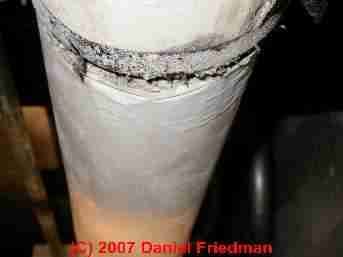
When asbestos pipe insulation is in good, un-damaged condition like this, and when it is found in an area not subject to mechanical damage, current advice is to leave this material alone.
However where this material was used on heating or other plumbing pipes, there remains the possibility that some of it will eventually have to be disturbed and removed when leaks occur and repairs to the piping are necessary.
Leaks in heating pipes should occur less often than in other plumbing lines, so this risk may be pretty small.
Use of asbestos for pipe coverings has been banned in the U.S. since 1975.
This ceiling fireproofing used in an office building basement storage area was readily identified as tremolite and was considered hazardous even though it was in good condition.
This product was quite friable, subject to being disturbed by ongoing work in the area, and needed professional asbestos removal.
See FIREPROOFING ASBESTOS SPRAY-ON.
Other examples of asbestos containing materials that might be safe to leave in place, or to leave in place after painting, sealing, or covering-over include:
- ASBESTOS FLOORING LEFT IN PLACE
- ASBESTOS CEMENT SIDING
- ASBESTOS CEMENT SIDING REPLACEMENT
- ASBESTOS & FIBER CEMENT ROOFING
Question: does this pipe insulation look like asbestos?
(Aug 30, 2017) Jefrla said:
I've got a query about pipe lagging which I think contains wool felt only but I'm concerned it might in fact be asbestos based. The lagging appears old (material cover with metal band, and around old pipes). When viewed end on it doesnt appear to contain any whiteish material e.g. Asbestos air cell or paper next to the pipe.
A licensed asbestos surveyor has come and had a quick look at it for me and said it wasn't asbestos. However the piping was well above his head height and so I wonder how accurate his brief visual assesment was. I didn't say I thought it was wool felt at the time, I just asked if it contained asbestos.
Assuming it to be safe I extracted a little of the material using forceps, and it does look like the images of wool felt I have found on the internet. It's quite firm and it feels and looks like a tangle of fibres in different sizes and directions. Some are curly, and they are not all the same browny colour. It does look wool like and it is not easily crumbled. It doesn't contain obvious bundles of fibres. (Can email photos).
My concern is that the surveyor might have made a mistake and that I have exposed myself to amosite fibres to a dangerous degree. Could this material be asbestos based insulation rather than wool felt (e.g caposite mounded insulation which I know contains brown amosite)? Would you expect old pipes to be insulated only with wool felt or is there likely to be some asbestos in there.
If it is asbestos-containing how concerned do you think I should be if I pulled away a small sample, say 2mm by 2mm, and have immediately kept it in a sealed plastic bag?
Many thanks for any information or advice! As you can tell I'm quite worried, especially about my own actions. -
Reply: No. Let's look at the lab sample.
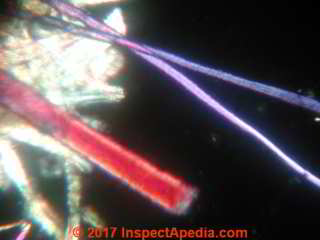 I looked at your photos - and with the caveat that nobody can make a certain identification of painted-over pipe insulation just by etext and photos, I do not see the typical corrugated paper asbestos at the exposed pipe ends that would characterize traditional asbestos based pipe insulation.
I looked at your photos - and with the caveat that nobody can make a certain identification of painted-over pipe insulation just by etext and photos, I do not see the typical corrugated paper asbestos at the exposed pipe ends that would characterize traditional asbestos based pipe insulation.
There was also an asbestos paste lagging (not corrugated asbestos paper) used at pipe elbows but that would not have been used along lengths of pipe.
In several areas including in the U.K. and the U.S. companies have for some time offered various forms of felt-based pipe insulation that is an alternative to fiberglass (less annoying and irritating to work-with) to insulate new pipes or to replace asbestos pipe insulation that was removed.
From what I can see in your photos the pipe insulation is wrapped and painted - measures that keep dust and fibre release down to a minimum. The brown fibres don't look like asbestos but of course that's an imperfect assessment from photographs.
Reader follow-up:
The property is in a town on the south coast (UK). It’s approximately 130 years old.
I’m afraid I don’t know if the lagging is original or a replacement. I’m afraid the remaining areas of bare pipe along the pipe run were repainted last summer, but I’ll include a photo of both ends anyway in case it’s of any use.
Reply:
I've had a look at the (really tiny) material samples that you sent to me - if these are representative of the pipe insulation about which you asked, we can say with confidence that the material is a mix of fibres including cotton, wool, and some synthetics.
There was no asbestos visible in the material and there were no significant levels of sub-micron particulates that might have raised an indoor air quality or asbestos worry.
Attached are several lab photos of your sample in transmitted and polarized light up to 720x.
These do not resemble the tremolite asbestos about which you asked.
...
Reader Comments, Questions & Answers About The Article Above
Below you will find questions and answers previously posted on this page at its page bottom reader comment box.
Reader Q&A - also see RECOMMENDED ARTICLES & FAQs
On 2021-01-18 - by (mod) -
That is corrugated asbestos paper pipe insulation.
Unfortunately when your asbestos pipe insulation is falling off, it needs attention by an expert. If it's just that one bit that's loose, you might want to have the insulation left alone, encapsulated, in place as a safer and less costly procedure than removing it all.
On 2021-01-17 by Vincent Carden
2nd photo of corrugated asbestos paper on pipes
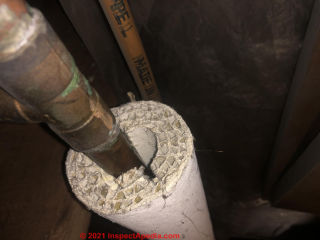
Does this look like the kind of pipe insulation I should be worried about? It’s spread through the basement, many pieces are whole and in good shape but many others are cut and damaged, flaking. I’ll leave another comment with another photo. Thank you.
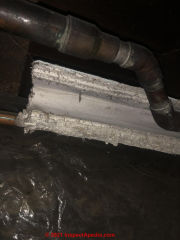
On 2020-12-03 - by (mod) -
Al
I can't say from your photo if there is asbestos insulation on your heating pipes or not, as I cannot see any piping in your photo.
In general, IF there is asbestos pipe insulation, and if it's in good condition, you can and should leave it alone. If there is a tiny area of suspected damage such as at your circle it'd be less expensive by far to simply wrap or tape and seal that area than to get into an asbestos abatement contract.
But if as I suspect your piping is in a school in the U.S. then it's not likely that asbestos pipe insulation would be permitted in a classroom; you might give your country and city or check with your local health officials.
And in any case, even if the insulation is simply fiberglass or something else, if it's in a location subject to damage from kids standing on it or kicking it then the piping needs to be enclosed and so protected from damage. Else you're asking for more than damaged insulation, risking a leak, building damage, mold contamination, hot water burns, and loss of heat.
On 2020-12-02 by AL
Question about risk from pipe wrap?
Hi, I'm trying to find out about any asbestos risk from wrapped pipes used for a radiator? Building was most likely built in the 1950's. If I remember correctly (worked there awhile ago), the pipes seemed to have a plastery-texture that was possibly painted?
They seemed to be in good condition (except maybe the area circled in red in photo), but these pipes were in classrooms where students would knock into them occasionally with feet, chairs, etc. Sometimes they would be stepped on by kids trying to look out the window.
Do you think working around these for a few years would be a concern? Would the asbestos be in the outer layer or the inner layer?
Windows were closed in the winter since we had no A/C. Sorry I don't have a better photo. Thanks--

On 2020-08-18 - by (mod) -
Exposed:
I'd like to help but really I can't make out any detail that tells us if there's asbestos in your photo, nor can anybody possibly assess the risk to your bikes or things from such work. Most likely it's below the limits of detection but if there's dust and debris on your bike I'd wash it off.
On 2020-08-18 by Exposed pipes and drilling into walls
Hey there, I live in an old building in Oakland CA built around 1910-1920. Recently the landlord had her maintenance guy drilling holes into the outside wall by where we keep our bikes to expose some pipes (and separately to fix a leak in my neighbors kitchen sink?!).
Anyway, I figure the building has plenty of asbestos but I’m wondering how safe is it for him to be doing work like this around our things. Took one bad photo of some of the exposed pipes, would appreciate any info you have to give. Thanks!
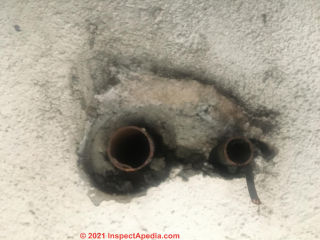
On 2020-02-09 - by (mod) -
Not with confidence from just your photo, but it looks to me like a putty-type sealant based pipe wrap, possibly coated with asphalt, or similar material
On 2020-02-09 by Marina
Can you recognize what this wrap pipe insulation is made of? House was built in the mid 60s. I don't know when the pipe was wrapped.
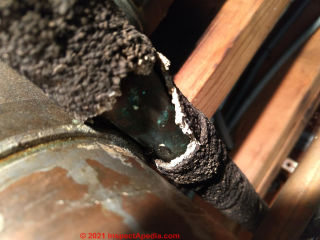
...
Continue reading at ASBESTOS in POOR CONDITION or select a topic from the closely-related articles below, or see the complete ARTICLE INDEX.
Or see these
Recommended Articles
Suggested citation for this web page
ASBESTOS in GOOD CONDITION at InspectApedia.com - online encyclopedia of building & environmental inspection, testing, diagnosis, repair, & problem prevention advice.
Or see this
INDEX to RELATED ARTICLES: ARTICLE INDEX to ASBESTOS HAZARDS
Or use the SEARCH BOX found below to Ask a Question or Search InspectApedia
Ask a Question or Search InspectApedia
Questions & answers or comments about when asbestos materials can or should be left alone & how to recognize asbestos materials that are undamaged and in good condition.
Try the search box just below, or if you prefer, post a question or comment in the Comments box below and we will respond promptly.
Search the InspectApedia website
Note: appearance of your Comment below may be delayed: if your comment contains an image, photograph, web link, or text that looks to the software as if it might be a web link, your posting will appear after it has been approved by a moderator. Apologies for the delay.
Only one image can be added per comment but you can post as many comments, and therefore images, as you like.
You will not receive a notification when a response to your question has been posted.
Please bookmark this page to make it easy for you to check back for our response.
IF above you see "Comment Form is loading comments..." then COMMENT BOX - countable.ca / bawkbox.com IS NOT WORKING.
In any case you are welcome to send an email directly to us at InspectApedia.com at editor@inspectApedia.com
We'll reply to you directly. Please help us help you by noting, in your email, the URL of the InspectApedia page where you wanted to comment.
Citations & References
In addition to any citations in the article above, a full list is available on request.
- 3/07: thanks to Gary Randolph, Ounce of Prevention Home Inspection, LLC Buffalo, NY, for attentive reading and editing suggestions. Mr. Randolph can be reached in Buffalo, NY, at (716) 636-3865 or email: gary@ouncehome.com
- 06/07: thanks for photographs of transite asbestos heating ducts, courtesy of Thomas Hauswirth, Managing Member of Beacon Fine Home Inspections, LLC and (in 2007) Vice President, Connecticut Association of Home Inspectors Ph. 860-526-3355 Fax 860-526-2942 beaconinspections@sbcglobal.net
- June 1997 - Window Putty - OSHA case cites contractor for asbestos exposure during removal of window putty http://www.osha.gov/pls/oshaweb/owadisp.show_document?p_table=NEWS_RELEASES&p_id=1091
- Asbestos Identification and Testing References
- Asbestos Identification, Walter C.McCrone, McCrone Research Institute, Chicago, IL.1987 ISBN 0-904962-11-3. Dr. McCrone literally "wrote the book" on asbestos identification procedures which formed the basis for current work by asbestos identification laboratories.
- Stanton, .F., et al., National Bureau of Standards Special Publication 506: 143-151
- Pott, F., Staub-Reinhalf Luft 38, 486-490 (1978) cited by McCrone
- ASBESTOS IN YOUR HOME U.S. EPA, Exposure Evaluation Division, Office of Toxic Substances, Office of Pesticides and Toxic Substances, U.S. Environmental Protection Agency, Washington,D.C. 20460
- Asbestos products and their history and use in various building materials such as asphalt and vinyl flooring includes discussion which draws on ASBESTOS, ITS INDUSTRIAL APPLICATIONS, ROSATO 1959, D.V. Rosato, engineering consultant, Newton, MA, Reinhold Publishing, 1959 Library of Congress Catalog Card No.: 59-12535 (out of print, text and images available at InspectAPedia.com).
- "Handling Asbestos-Containing roofing material - an update", Carl Good, NRCA Associate Executive Director, Professional Roofing, February 1992, p. 38-43
- EPA Guidance for Controlling Asbestos-Containing Materials in buildings, NIAST, National Institute on Abatement Sciences & Technology, [republishing EPA public documents] 1985 ed., Exposure Evaluation Division, Office of Toxic Substances, Office of Pesticides and Toxic Substances, U.S. Environmental Protection Agency, Washington,D.C. 20460
- In addition to citations & references found in this article, see the research citations given at the end of the related articles found at our suggested
CONTINUE READING or RECOMMENDED ARTICLES.
- Carson, Dunlop & Associates Ltd., 120 Carlton Street Suite 407, Toronto ON M5A 4K2. Tel: (416) 964-9415 1-800-268-7070 Email: info@carsondunlop.com. Alan Carson is a past president of ASHI, the American Society of Home Inspectors.
Thanks to Alan Carson and Bob Dunlop, for permission for InspectAPedia to use text excerpts from The HOME REFERENCE BOOK - the Encyclopedia of Homes and to use illustrations from The ILLUSTRATED HOME .
Carson Dunlop Associates provides extensive home inspection education and report writing material. In gratitude we provide links to tsome Carson Dunlop Associates products and services.


